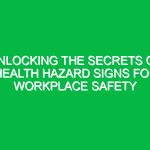Introduction
In the world of Health, Safety, and Environment (HSE), hazard warning symbols play a crucial role in ensuring safety across various industries. These symbols serve as visual cues that communicate potential risks and necessary precautions effectively. Understanding these symbols is not just about compliance; it’s about fostering a culture of safety that protects lives and the environment. This article delves into the significance of hazard warning symbols, exploring their various aspects, regulations, and best practices that can help enhance safety in workplaces and beyond.
Understanding Hazard Warning Symbols
Hazard warning symbols are graphical representations designed to convey information about specific hazards associated with materials, machinery, or work processes. They are an integral part of safety signage, providing immediate recognition of dangers and guiding individuals on appropriate responses. For example, a symbol indicating flammable materials warns workers to handle substances with caution to prevent fires or explosions.
The origins of these symbols can be traced back to the need for universal communication in safety. People cannot always communicate verbally, especially in high-risk environments where noise or language barriers exist. Thus, these symbols have evolved to transcend language, ensuring that everyone, regardless of their background, understands the risks involved.
The Importance of Hazard Warning Symbols in HSE
The significance of hazard warning symbols in the HSE domain cannot be overstated. Here are some key reasons why they are essential:
- Risk Communication: Hazard warning symbols provide immediate visual communication about potential dangers, allowing individuals to respond appropriately.
- Legal Compliance: Many industries are governed by regulations that mandate the use of specific symbols to inform employees about safety risks.
- Training and Awareness: These symbols serve as educational tools, helping workers recognize hazards and understand safety protocols.
- Cultural Impact: Consistent use of hazard symbols fosters a safety-oriented culture, encouraging employees to prioritize safety in their daily tasks.
Key Hazard Warning Symbols in HSE
Understanding the various hazard warning symbols is critical for anyone involved in health and safety management. Below are some of the most common symbols encountered in various industries:
1. Flammable Materials
The symbol for flammable materials typically features a flame icon. It alerts workers to the presence of substances that can ignite easily, such as solvents or gases. Recognizing this symbol is vital in environments like laboratories or construction sites, where flammable materials may be present.
2. Toxic Substances
This symbol is represented by a skull and crossbones, indicating the presence of toxic substances that can cause severe health issues or even death upon exposure. Workers dealing with chemicals must be particularly vigilant when encountering this symbol to ensure they employ the necessary precautions.
3. Corrosive Materials
The corrosive symbol, often depicted as a test tube spilling substance onto skin and metal, signifies that the material can cause destruction to living tissue or severe corrosion to materials. Industries handling acids and alkalis must ensure they understand this symbol’s implications.
4. Electrical Hazard
The lightning bolt symbol warns of electrical risks, including exposed wiring or live electrical components. This symbol is critical in environments such as construction sites or maintenance areas, where electrical equipment is frequently used.
5. Radiation
A trefoil symbol represents radiation hazards. It is crucial in healthcare, nuclear power, and research facilities, where exposure to radiation can pose serious health risks.
6. Biological Hazard
The biohazard symbol is used to indicate the presence of biological substances that pose a threat to the health of living organisms. This symbol is often found in healthcare settings and laboratories handling infectious materials.
7. General Warning
A triangle symbol with an exclamation mark inside serves as a general warning. This symbol indicates that caution is necessary, often used in conjunction with other specific hazard symbols to alert individuals to potential danger.
Regulations and Standards Governing Hazard Warning Symbols
The use of hazard warning symbols is not merely a suggestion; it is often mandated by various regulations and standards designed to protect workers and the environment. Here are some key regulations that emphasize the importance of these symbols:
1. OSHA Regulations
In the United States, the Occupational Safety and Health Administration (OSHA) enforces regulations concerning hazard communication. OSHA‘s Hazard Communication Standard (HCS) requires that chemical manufacturers and importers provide labels and safety data sheets that include hazard symbols to inform users about potential dangers associated with their products.
2. GHS (Globally Harmonized System)
The GHS is an international standard that aims to provide a consistent approach to classifying chemicals and communicating hazards through labels and safety data sheets. The GHS has standardized symbols that are recognized globally, making it easier for workers to understand hazards, regardless of their location.
3. EU Regulations
In Europe, the Classification, Labeling and Packaging (CLP) Regulation aligns with the GHS and mandates that hazardous substances and mixtures be classified and labeled with appropriate hazard symbols. Compliance with these regulations is essential for companies operating within the EU.
Best Practices for Implementing Hazard Warning Symbols
To effectively use hazard warning symbols in the workplace, organizations should adopt best practices that enhance their visibility and understanding. Here are some actionable recommendations:
1. Training and Education
Regular training sessions should be conducted to educate employees about the meaning of various hazard symbols and the associated risks. This training should be a part of the onboarding process for new employees and ongoing safety programs for existing staff.
2. Visibility and Placement
Hazard warning symbols should be placed in locations where they are easily visible. High-traffic areas or zones where specific hazards exist should prominently feature relevant symbols to ensure maximum awareness.
3. Regular Reviews
Safety protocols should be regularly reviewed and updated. As new materials or processes are introduced, it’s important to reassess the hazard symbols in use and ensure they remain relevant and compliant with current regulations.
4. Encourage Reporting
Create an open environment where employees feel comfortable reporting missing or damaged hazard symbols. This encourages proactive safety management and ensures that all hazards are adequately communicated.
Real-Life Examples and Anecdotes
To illustrate the importance of hazard warning symbols, consider the case of a manufacturing plant that recently restructured its safety protocols. After a near-miss incident involving a flammable chemical spill, the management realized that their existing hazard symbols were outdated and not easily recognizable. They organized a comprehensive training program focusing on hazard symbols, updated their signage, and implemented regular safety drills.
The results were noteworthy. Within months, incidents related to chemical handling decreased significantly. Employees reported feeling more secure and aware of their surroundings, demonstrating the profound impact that effective hazard communication can have on workplace safety.
Conclusion
Hazard warning symbols are more than just regulatory requirements; they are vital tools for promoting safety in the workplace. By understanding and effectively implementing these symbols, organizations can significantly reduce the risk of accidents and create a safer environment for everyone involved. As we move forward in our commitment to health, safety, and environmental sustainability, embracing hazard warning symbols will remain a cornerstone of effective safety management. It is not only about compliance; it is about fostering a culture of safety that prioritizes the well-being of all. Let us all continue to unlock the potential of these essential symbols in our journey towards safer workplaces.


